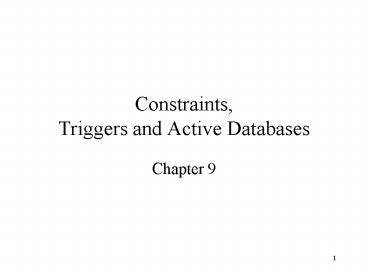Constraints, Triggers and Active Databases - PowerPoint PPT Presentation
Title:
Constraints, Triggers and Active Databases
Description:
Activation - Occurrence of the event. Consideration - The point, after activation, when ... How should multiple triggers activated by a single event be handled? ... – PowerPoint PPT presentation
Number of Views:23
Avg rating:3.0/5.0
Title: Constraints, Triggers and Active Databases
1
Constraints,Triggers and Active Databases
- Chapter 9
2
Integrity Constraints (Reminder)
- Key (relation) a list of attributes
- Primary key (Sql PRIMARY KEY)
- Secondary key (UNIQUE)
- Foreign key (inter-relation) from R1 to R2
- Referenced attributes (in R2) must be UNIQUE or
PRIMARY KEY - Values of the foreign key in R1 must appear in R2
- Sql FOREIGN KEY (ltattsgt) REFERENCES R2(ltattsgt)
3
Enforcing Foreign Key Constraints
- FOREIGN KEY (ltattsgt) REFERENCES R2(ltattsgt)
- Reject violation (default mode)
- Insert in R1 some tuple whose value (ltattsgt) is
not in R2 rejected - Update in R1 some tuple whose value (ltattsgt) is
not in R2 rejected - Delete in R2 some tuple whose value (ltattsgt) is
in R1 rejected - Update in R2 some tuple whose value (ltattsgt)
changed and the old value appear in some tuples
R1 rejected - Cascade Change in R2 will be updated to R1
- Delete in R2 some tuple whose value (ltattsgt) is
in R1 tuples with corresponding value are
deleted in R1 - Update in R2 some tuple whose value (ltattsgt)
changed and the old value appear in some tuples
R1 changes made in R1 - Set-Null Change in R2 will be updated to R1
- Delete in R2 some tuple whose value (ltattsgt) is
in R1 value of (ltattsgt) are set to NULL - Update in R2 some tuple whose value (ltattsgt)
changed and the old value appear in some tuples
R1 value of (ltattsgt) are set to NULL
4
IC Attribute-Based Constraints
- NULL valued prohibited (Sql NOT NULL)
- CHECK
- attribute-based CHECK (cond) where cond can be
anything that can occur in a SQL query
(select-from-where-cond), use with care! - tuple-based same as attribute-based
5
IC Schema-Level Based
- Assertions A boolean-valued SQL expression that
must be true at all time - Sql CREATE ASSERTION ltnamegt
- CHECK ltconditiongt
- ltnamegt name of the assertion
- ltconditiongt condition that can occur in a SQL
query (select-from-where-cond) - must be true at the time the assertion is created
- must remain true ALL the time
6
IC Schema-Level Based Trigger
- Element of the database schema
- General form
ON lteventgt IF
ltconditiongt THEN ltactiongt - Event- request to execute database operation
- Condition - predicate evaluated on database state
- Action execution of procedure that might
involve database updates - Example
ON updating
maximum course enrollment IF number
registered gt new max enrollment limit THEN
deregister students using LIFO policy
7
Trigger Details
- Activation - Occurrence of the event
- Consideration - The point, after activation, when
condition is evaluated - Immediate or deferred (when the transaction
requests to commit) - Condition might refer to both the state before
and the state after event occurs
8
Trigger Details
- Execution - point at which action occurs
- With deferred consideration, execution is also
deferred - With immediate consideration, execution can occur
immediately after consideration or it can be
deferred - If execution is immediate, execution can occur
before, after, or instead of triggering event. - Before triggers adapt naturally to maintaining
integrity constraints violation results in
rejection of event.
9
Trigger Details
- Granularity -
- Row-level granularity change of a single row is
an event (a single UPDATE statement might result
in multiple events) - Statement-level granularity events are
statements (a single UPDATE statement that
changes multiple rows is a single event).
10
Trigger Details
- Multiple Triggers
- How should multiple triggers activated by a
single event be handled? - Evaluate one condition at a time and if true
immediately execute action or - Evaluate all conditions, then execute actions
- The execution of an action can affect the truth
of a subsequently evaluated condition so the
choice is significant.
11
Triggers in SQL/3
- Events INSERT, DELETE, or UPDATE statements or
changes to individual rows caused by these
statements - Condition Anything allowed in a WHERE clause
- Action An individual SQL statement or a program
written in the language of Procedural Stored
Modules (PSM) (which can contain embedded SQL
statements)
12
Triggers in SQL1999
- Consideration Immediate
- Condition can refer to both the state of the
affected row or table before and after the event
occurs - Execution Immediate - can be before or after
the execution of triggering event . - Action of before trigger cannot modify the
database - Granularity Both row-level and statement-level
granularity
13
Before Trigger Example(row granularity)
CREATE TRIGGER Max_EnrollCheck BEFORE INSERT
ON Transcript REFERENCING NEW AS N
--row to be added FOR EACH ROW WHEN
((SELECT COUNT (T.StudId) FROM Transcript T
WHERE T.CrsCode N.CrsCode
AND T.Semester N.Semester) gt
(SELECT C.MaxEnroll FROM Course C WHERE
C.CrsCode N.CrsCode )) ABORT TRANSACTION
14
After Trigger Example(row granularity)
CREATE TRIGGER LimitSalaryRaise AFTER UPDATE
OF Salary ON Employee REFERENCING OLD AS O
NEW AS N FOR EACH ROW
WHEN (N.Salary - O.Salary gt 0.05 O.Salary)
UPDATE Employee -- action
SET Salary 1.05 O.Salary WHERE Id
O.Id
Note The action itself is a triggering event
(but in this case a chain reaction is not
possible)
15
After Trigger Example(statement granularity)
CREATE TRIGGER RecordNewAverage AFTER UPDATE
OF Salary ON Employee FOR EACH STATEMENT
INSERT INTO Log VALUES (CURRENT_DATE,
SELECT AVG (Salary)
FROM Employee)































